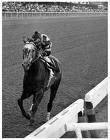In his book, Modern Pace Handicapping, Tom Brohamer takes a shot at presenting the Sartin methodology in layman's terms.
It involves simple math in determining feet per second calculations based on running lines and beaten lengths. The numbers are then compared to a track bias based on running styles and winning percentages.
The calculations are easy and reveal exact figures that any data cruncher would be happy to have.
The problem is, those precise numbers are derived from information that is spotty at best. The numbers are taken from the running lines, which are made by the chart callers. At the various points of call, the person in charge of calling out beaten lengths and running order, is guesstimating where the horse is in relation to the other horses and they are doing this for all the horses in a race, 9,10,11 times a day.
What is the argument against putting RFID chips in the saddle cloths? Is this really such a point of contention, that tracks and racing execs think more and better information would be detrimental to the game? If the information were better, more people might be inclined to play. The track could then rake their standard usurious rate from the pool.
Open source the information. Why isn't Google working on this? Get Sergei on the phone. Doesn't Google have some mechanism where one can submit ideas for their crazy time off projects? Everyone is encouraged to pursue something not business related and Google will let them do it. At least one of their employees must have, at least heard, of horse racing.
22 January 2009
On Sartin, Hackers and the Snafu principle
Subscribe to:
Post Comments (Atom)
The Bid

Greatest horse ever to look through a bridle





8 comments:
Deauville tested a system called "trakus" this year, with the saddle-cloth chip, and I think it was wonderful. My only quibble is that the transponder is a little big, and it went in the middle of the saddle cloth on the back, so it sat right on the horse's spine. Some trainers refused to carry the transponders, but by the end of the season, most were going along. The system gave various views of the race, including allowing you to follow the jockey-eye view for your own horse. A system like this, with open information for all, as you say, would be a boon to fans and everyone connected with the sport. There is no reason to withhold this information.
Is what you're proposing different from Trakus? Keeneland and some other tracks have that. Looks like chicklets on the screen ...
I'm proposing the acceptance of the standard in an open source medium. The tracks won't give it away and this might have something to do with why more tracks don't use it.
The technology can't be that expensive. I think there has to be a way for this to make it out there. It could provide so much more than running lines. One could see acceleration and ground lost and whatever else.
It's not being used to its potential.
According to Charlie Hayward at Saratoga last year, the Trackus system costs $75,000 to install and carries with it a $2,000 daily operating fee. Hayward characterized it as an innovation that doesn't offer any return on investment: once installed, the system doesn't bring any additional revenue to the track, and as such, the New York tracks were putting other initiatives far above installing Trackus.
I hate to be the cold hearted corporate suit, but that's what I am: Capital Expenditures have to be paid back.
If I was the suit involved I'd try to figure out some sort of subscription service. Bettors and horse fans that pay extra, get the information, everyone else, no chicklets.
You'd have to sell it to the ADWs to make it work. The tracks won't see any upside from it.
It's always about money.
I think the system they're going toward here is that the "chicklets" appear during the race and the tv guys can use some of the fun replay stuff, but if the public wants to play with it themselves, they'll have to pay a fee for online access to the data. We trainers have no access other than what they show us at the track. Not sure if the stewards get to play (the stewards probably don't care...most of them would be insulted if you suggested they might want/need a better tool).
In any case, I think most of our tracks wouldn't support it. It is only in Deauville because the fibersand there is what they called "American-style", meaning not too big for the system to work.
The Turk said is best: "It is all about money". Hayward of NYRA is right-no return on investment-but--how about customer service???????
They just don't get it.
The comment that I left was incomplete, because I didn't think that the rest of it was relevant, but apparently it is. Hayward said that of all the non-revenue generating expenditures they were considering, endeavors such as improved backstretch housing were higher on the list than Trackus. I'd have to agree with him, as much as I like that system. It was about priorities, not profit.
Post a Comment